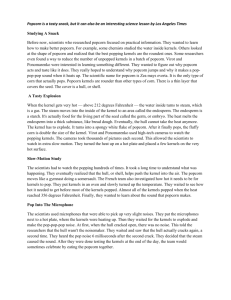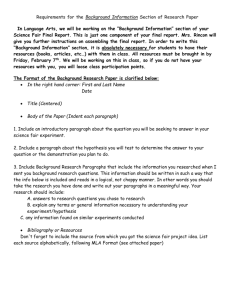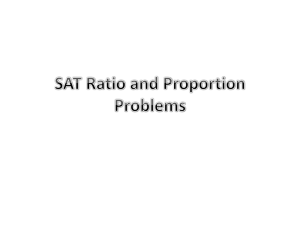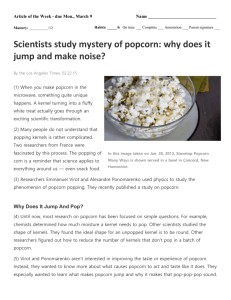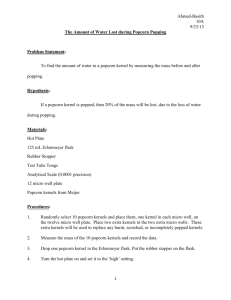Tab 8 - Popcorn Laboratory
advertisement
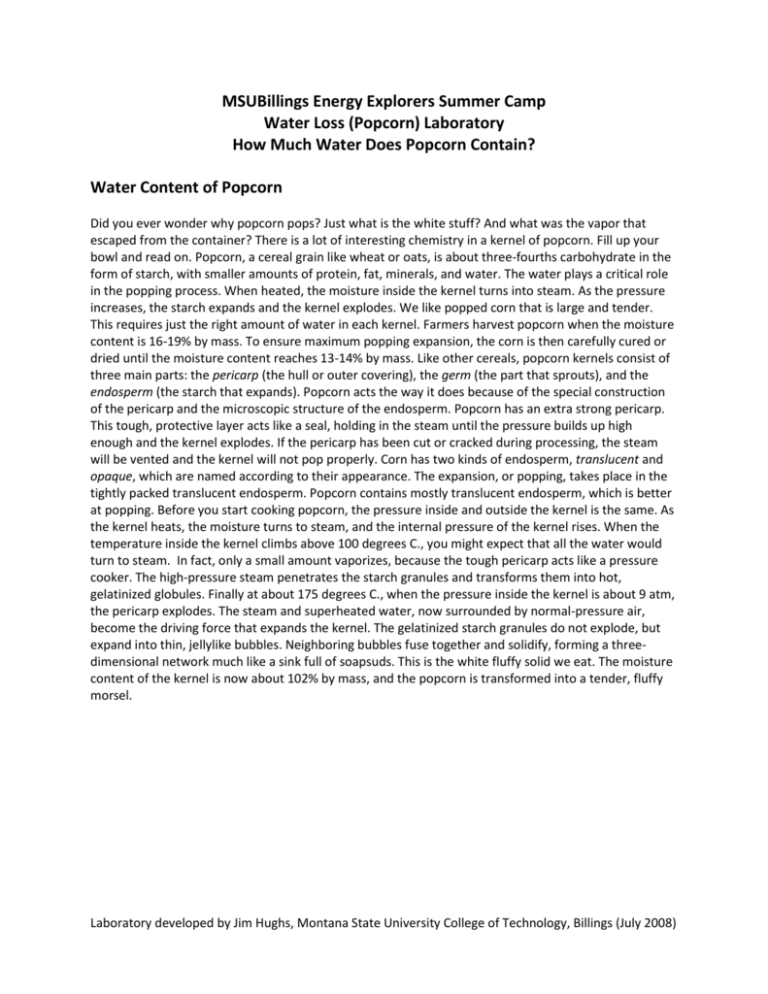
MSUBillings Energy Explorers Summer Camp Water Loss (Popcorn) Laboratory How Much Water Does Popcorn Contain? Water Content of Popcorn Did you ever wonder why popcorn pops? Just what is the white stuff? And what was the vapor that escaped from the container? There is a lot of interesting chemistry in a kernel of popcorn. Fill up your bowl and read on. Popcorn, a cereal grain like wheat or oats, is about three-fourths carbohydrate in the form of starch, with smaller amounts of protein, fat, minerals, and water. The water plays a critical role in the popping process. When heated, the moisture inside the kernel turns into steam. As the pressure increases, the starch expands and the kernel explodes. We like popped corn that is large and tender. This requires just the right amount of water in each kernel. Farmers harvest popcorn when the moisture content is 16-19% by mass. To ensure maximum popping expansion, the corn is then carefully cured or dried until the moisture content reaches 13-14% by mass. Like other cereals, popcorn kernels consist of three main parts: the pericarp (the hull or outer covering), the germ (the part that sprouts), and the endosperm (the starch that expands). Popcorn acts the way it does because of the special construction of the pericarp and the microscopic structure of the endosperm. Popcorn has an extra strong pericarp. This tough, protective layer acts like a seal, holding in the steam until the pressure builds up high enough and the kernel explodes. If the pericarp has been cut or cracked during processing, the steam will be vented and the kernel will not pop properly. Corn has two kinds of endosperm, translucent and opaque, which are named according to their appearance. The expansion, or popping, takes place in the tightly packed translucent endosperm. Popcorn contains mostly translucent endosperm, which is better at popping. Before you start cooking popcorn, the pressure inside and outside the kernel is the same. As the kernel heats, the moisture turns to steam, and the internal pressure of the kernel rises. When the temperature inside the kernel climbs above 100 degrees C., you might expect that all the water would turn to steam. In fact, only a small amount vaporizes, because the tough pericarp acts like a pressure cooker. The high-pressure steam penetrates the starch granules and transforms them into hot, gelatinized globules. Finally at about 175 degrees C., when the pressure inside the kernel is about 9 atm, the pericarp explodes. The steam and superheated water, now surrounded by normal-pressure air, become the driving force that expands the kernel. The gelatinized starch granules do not explode, but expand into thin, jellylike bubbles. Neighboring bubbles fuse together and solidify, forming a threedimensional network much like a sink full of soapsuds. This is the white fluffy solid we eat. The moisture content of the kernel is now about 102% by mass, and the popcorn is transformed into a tender, fluffy morsel. Laboratory developed by Jim Hughs, Montana State University College of Technology, Billings (July 2008) MATERIAL(S): Popcorn Cooking oil Reactor (popcorn popper) Bowl Precision Scale (Explorer model) OBJECTIVE(S): To determine how much water popcorn contains by weighing pre- and post-popping OVERVIEW: Explain the concept of how popcorn pops (popcorn contains a small amount of water, which, when heated, expands and creates steam; the pressure breaks the hull, the kernel turns inside out and the steam escapes). Put a specific number of kernels (ex. 20) into a container and weigh (or, measure the mass of the popcorn, in grams). You must weigh the empty bowl before doing this, record this number, and subtract it from the overall weight to obtain the actual mass of the popcorn. Weigh the reactor at room temperature. (You will use this number to calculate the amount of oil remaining in the reactor after the corn has been transferred to the bowl.) Record the number of kernels and mass. Place 30 ml of cooking oil in a graduated cylinder and weigh. Add the cooking oil to the reactor. Weigh the cylinder after the oil has been added, and this will be the weight of oil added to the reactor. pop the popcorn in the reactor. When the popcorn is done popping, place it and any remaining unpopped popcorn and hulls into the bowl. Weigh the cooled reactor and subtract the original weight of the reactor. THIS NUMBER MUST BE SUBTRACTED FROM THE ACTUAL AMOUNT OF OIL WHICH WAS ADDED TO THE REACTOR TO OBTAIN THE AMOUNT OF OIL REMAINING IN THE POPCORN! Weigh again and record weight. Remember to subtract the weight of the bowl and the oil. Calculations of Mass: Number of kernels before cooking: _____N1 Weight of kernels before cooking: _____W1 Number of kernels after cooking: _____N2 Weight of kernels after cooking: _____W2 Mass of kernels before cooking: _____M1=W1/N1 (W1 divided by N1) Mass of kernels after cooking: _____M2=W2/N2 Mass of water in one kernel: _____M3=M1-M2 Calculations of Percentage: Weight of kernels before cooking: _____W1 Weight of kernels after cooking: _____W2 Grams of water: _____G1=W1-W2 Percent of water in unpopped popcorn: ______P1=G1/W1 x 100 Laboratory developed by Jim Hughs, Montana State University College of Technology, Billings (July 2008) Note to instructor: Develop an Excel Spreadsheet for this calculation prior to beginning work with younger students. This product was funded by a grant awarded under the President’s Community-Based Job Training Grants as implemented by the U.S. Department of Labor’s Employment & Training Administration. The information contained in this product was created by a grantee organization and does not necessarily reflect the official position of the U. S. Department of Labor. All references to non-governmental companies or organizations, their services, products, or resources are offered for informational purposes and should not be construed as an endorsement by the Department of Labor. This product is copyrighted by the institution that created it and is intended for individual organizational, noncommercial use only. Laboratory developed by Jim Hughs, Montana State University College of Technology, Billings (July 2008)
